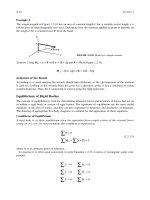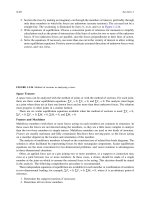Crc Press - Mechanical Engineering Handbook - Robotics 1 Part 3 ppsx
Bạn đang xem bản rút gọn của tài liệu. Xem và tải ngay bản đầy đủ của tài liệu tại đây (28.56 KB, 1 trang )
14-20 Section 14
© 1999 by CRC Press LLC
The Jacobian can be used to perform inverse kinematics at the velocity level as follows. If we define
[J
–1
] to be the inverse of the Jacobian (assuming J is square and nonsingular), then
(14.3.10)
and the above expression can be solved iteratively for (and hence q by numerical integration) given
a desired end effector trajectory and the current state q of the manipulator. This method for determining
joint trajectories given desired end effector trajectories is known as Resolved Rate Control and has
become increasingly popular. The technique is particularly useful when the positional inverse kinematics
is difficult or intractable for a given manipulator.
Notice, however, that the above expression requires that J is both nonsingular and square. Violation
of the nonsingularity assumption means that the robot is in a singular configuration, and if J has more
columns than rows, then the robot is kinematically redundant. These two issues will be discussed in the
following subsections.
Example 14.3.4
By direct differentiation of the forward kinematics derived earlier for our example,
(14.3.11)
Notice that each column of the Jacobian represents the (instantaneous) effect of the corresponding
joint on the end effector motions. Thus, considering the third column of the Jacobian, we confirm that
the third joint (with variable d
3
) cannot cause any change in the orientation (φ) of the end effector.
Singularities
A significant issue in kinematic analysis surrounds so-called singular configurations. These are defined
to be configurations q
s
at which J(q
s
) has less than full rank (Spong and Vidyasagar, 1989). Physically,
these configurations correspond to situations where the robot joints have been aligned in such a way
that there is at least one direction of motion (the singular direction[s]) for the end effector that physically
cannot be achieved by the mechanism. This occurs at workspace boundaries, and when the axes of two
(or more) joints line up and are redundantly contributing to an end effector motion, at the cost of another
end effector degree of freedom being lost. It is straightforward to show that the singular direction is
orthogonal to the column space of J(q
s
).
It can also be shown that every manipulator must have singular configurations, i.e., the existence of
singularities cannot be eliminated, even by careful design. Singularities are a serious cause of difficulties
in robotic analysis and control. Motions have to be carefully planned in the region of singularities. This
is not only because at the singularities themselves there will be an unobtainable motion at the end
effector, but also because many real-time motion planning and control algorithms make use of the (inverse
of the) manipulator Jacobian. In the region surrounding a singularity, the Jacobian will become ill-
conditioned, leading to the generation of joint velocities in Equation (14.3.10) which are extremely high,
even for relatively small end effector velocities. This can lead to numerical instability, and unexpected
wild motions of the arm for small, desired end effector motions (this type of behavior characterizes
motion near a singularity).
For the above reasons, the analysis of singularities is an important issue in robotics and continues to
be the subject of active research.
˙
˙
qJqY=
()
[]
−1
˙
q
˙
Y
˙
˙
˙
sin sin
cos cos
sin
cos
cos
sin
˙
˙
˙
x
y
ld
ld
d
d
dφ
θθθ
θθθ
θθ
θθ
θθ
θθ
θ
θ
=
−
()
−+
()
()
++
()
−+
()
+
()
+
()
+
()
11312
11312
312
312
12
12
1
2
3
110









